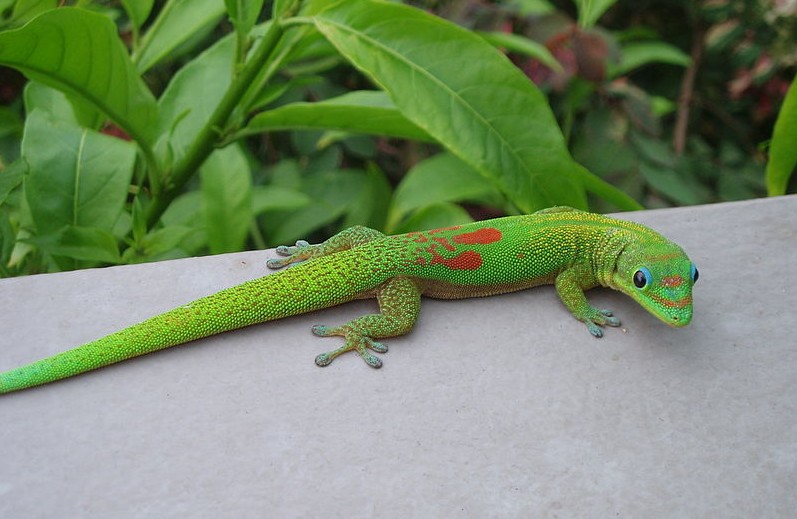The Gold Dust Day Gecko, also referred to as Broad-tailed Day Gecko and Phelsuma laticauda, is a lizard species native to Madagascar, but recently introduced to various Pacific Islands, including Hawaii. They are known to do best as display pets that require limited handling. Perfect for starting hobbyists, the Gold Dust Day Gecko possesses a shy demeanor, making it one of the favorites of many hobbyists. If you want to find out more about the Gold Dust Day Gecko, make sure to read further!
History
The Gold Dust Day Gecko was first described in 1880 by German zoologist Oskar Boettger. This gecko species is best known as the mascot of the Government Employees Insurance Company (GEICO), an American auto insurance company based in Maryland. The Gold Dust Day Gecko has one subspecies, the Phelsuma laticauda angularis. These lizards are primarily green in color, with red spots all over the body. Since their population is stable and there are no significant threats to their population, the International Union for the Conservation of Nature (IUCN) Red List categorized them as Least Concern.
Today, Gold Dust Day Geckos are widely available in the pet trade, although the majority of the species are not captive-bred in the US.
Characteristics of a Gold Dust Day Gecko
Average length: 4.5 to 9 inches
Average life span: 10 years in captivity
This species belongs to the common group smaller day geckos, possessing a bright or yellowish-green body. Sometimes, it can be blue. This lizard is specked with red spots on the neck, upper back, and head. Three rust-colored transverse bars are present on its head and snout, while the upper part of the skin around its eyes is blue. Its lower back is tapered with three red bars. Its tail is slightly flattened and the undersides are white in color. Baby Gold Dust Day Geckos lack red spots, and their limbs and tails are off white in color.
Gold Dust Day Geckos are diurnal, semi-arboreal lizards that are solitary in nature. In the wild, they frequent in semi-arid or humid forests, preferring to seek refuge in palms, small deciduous houses, and banana trees.
Their care necessities are similar to that of other day geckos, including Giant Day Geckos and Standing’s Day Geckos. If you want to pet one, it’s best to buy from reputable breeders than chain pet stores. As much as possible, avoid purchasing wild-caught geckos as they can be more susceptible to diseases.
Caring for a Gold Dust Day Geckos
These lizards are more of a display pet than a hands-on one, making them perfect for beginners. Gold Dust Day Geckos can be quick, fidgety, and flighty, which is why only minimum handling is required. They can drop their tails and shed pieces of skin when handled, so make sure to handle them rarely.
A single Gold Dust Day Gecko can be kept in a 12x12x18 enclosure. Pairs can also fit in this enclosure, but a 18x18x24 enclosure will secure more space for them. A bioactive set-up is essential for these geckos. Substrates that can hold moisture and help maintain live plants, isopods, and springtails are recommended. You may want to consider cypress mulch, orchid bark, coconut husk, or coconut fiber. Design the enclosure with branches, bamboo, cork barks, and other climbing accessories for these semi-arboreal geckos. As shy animals, they prefer hiding places and foliage. Add wood products to provide more hiding options to your pet and add visual interest to your enclosure.
A day ambient temperature between 75 and 80 degrees Fahrenheit, as well as a basking spot of around 90 degrees Fahrenheit are recommended. The ambient night temperature should not go below 65 degrees Fahrenheit. A UVB light with 5.0 or similar strength is also required. Make use of a digital thermometer to monitor the temperatures regularly.
Gold Dust Day Geckos do not necessarily need a water bowl because they cannot recognize standing water. However, you may still provide one for your pet. A better alternative is a water dripper. They consume a variety of invertebrates, flower nectar, pollen, fruits, and even other geckos. You can also provide powdered diets and healthy insects such as roaches, crickets, black soldier fly larvae, silkworms, butter worms, waxworms, and mealworms. Do not forget to gut-load these insects with fruit and vegetables two days before you feed them to your gecko.

